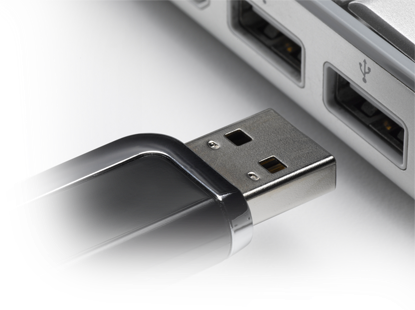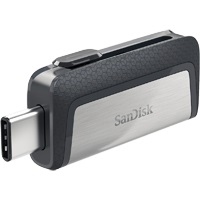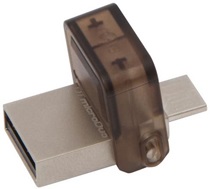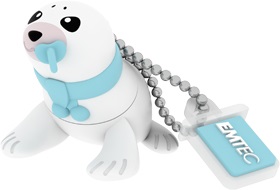How to Choose a Flash Drive
Flash drives are the most sought-after compact storage devices for transferring data, such as work documents and media files. The number of flash drives with different parameters available today can be overwhelming. We're here to help you navigate through this large range of drives, and to make sure you choose the right one.

How Should You Choose a Flash Drive? Here Are Some Tips
USB 3.1 flash drives reach high transfer speeds.
For multimedia files, choose the maximum capacity you can afford.
Office documents will transfer well with even low-capacity flash drives.
USB 3.1 flash drives are backward compatible with USB 2.0.
Frequently Asked Questions When Choosing a Flash Drive
Capacity
The fundamental parameter of a flash drive is its capacity. With the ever-increasing file sizes, capacity often becomes limiting, which is why we recommend that you get a drive with a higher capacity than you currently consider sufficient.
The Amount of Files You Can Store on a Flash Drive with a Given Capacity
| File Type | 4GB | 8GB | 16GB | 32GB | 64GB |
| HD video (min.) | 60 | 120 | 240 | 480 | 960 |
| Photos (10MP) | 1300 | 2600 | 5200 | 10,400 | 20,800 |
| Audio file (MP3) | 1000 | 2000 | 4000 | 8000 | 16,000 |
Read and Write Speed
Write speed determines how long it takes for your data to save to the flash drive, whereas read speed determines how fast you can transfer files from the flash drive or play them back. High write and read speeds become particularly noticeable when you're transferring large files.
Interface Comparison
| Interface | Connector | Bandwidth |
| USB 2.0 | USB-A, USB-C | 480Mb/s |
| USB 3.0 (3.1 Gen1) | 5Gb/s | |
| USB 3.1 (3.1 Gen2) | 10Gb/s |
The write and read speeds of USB 3.1 flash drives can be more than ten times higher than those of USB 2.0 drives.
Approximate File Transfer Time
| File Type | Approximate Size | Write time | Read time | ||
| USB 2.0 | USB 3.1 | USB 2.0 | USB 3.1 | ||
| Full HD film | 15GB | 31 min | 3.5 min | 7.5 min | 1 min |
| 100 photos | 1GB | 2 min | 15s | 65s | 9s |
| 50 songs | 250MB | 31s | 4s | 20s | 3s |
The read and the write speeds are significantly different. This is because reading only requires the system to find the exact physical location of the file in the memory cells, but not to change the cells. Writing, on the other hand, requires change in voltage in order to change the status of the cells. If cells contain old data, they must also be erased before the writing process can start. This results in lower write speeds.
Data Backup
Flash drives shouldn't be used to backup data. A limited number of write cycles (in the thousands) is enough for a casual user, but it can be limiting when it comes to frequent backups. Flash drives are also less reliable than hard drives and they're easy to lose. For backing up data, we recommend using an external hard drive, which also beats a flash drive when it comes to the price/capacity ratio.
OTG Flash Drives
Flash Drive Features


Encryption
If you're using your flash drive to transfer important files that unauthorised people shouldn't be able to access, you can't go wrong with an encrypted flash drive. Only those with a password will be able to access the data.

LED activity indicator
An LED flash drive is equipped with an LED activity indicator. It tells you when data is being written to or read from the drive.

Retractable Connector
To protect the connector, a retractable flash drive uses a mechanism that allows you to retract it when you're not using it. The connector is then shielded by the body of the flash drive when you carry it around.

Durable Design
Durable flash drives protect against accidental impact and water damage. We definitely recommend one of these if you're planning to carry the drive around often. Your data will stay safe in any situation.

Keychain Loop
You can easily attach a flash drive with a loop to your keys. You'll be sure to never lose it.
Glossary - Flash Drives
USB
USB, short for Universal Serial Bus, allows you to quickly and easily connect peripherals and other accessories to your computer or other devices. Connectors currently in use are USB 2.0, USB 3.0/3.1, and the latest USB Type-C.
Capacity
Something you should focus on when choosing a flash drive is memory capacity. It's crucial for the actual number of files you can save on the flash drive.
USB OTG
USB OTG (On the Go) flash drives are equipped with two connectors; one connects to a computer and the other to a mobile device.
Glossary







Water Resistance
If your waterproof flash drive gets splashed with water, or is forced to take short bath, your data stays safe. You never have to worry about the weather or minor accidents.